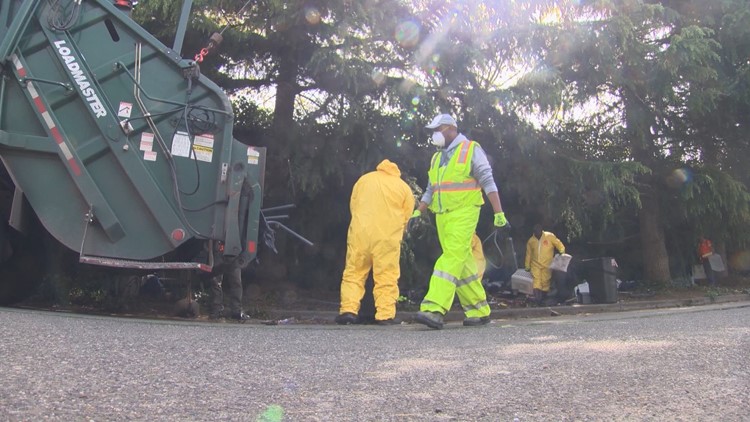Seattle spent more than $10 million in 2017 cleaning up and relocating people who live in unauthorized encampments.
That’s the number that jumps out of a 50-page memo authored by the Department of Finance and Administrative Services and sent to Councilmember Kshama Sawant earlier this month.
The memo, obtained recently by KING 5, will likely be part of a larger debate about how the City spends new revenue from the just-approved $45 million a year employee head tax.
It says the Navigation Team, created in 2017 and spread across resources for six city departments, takes into account labor, outreach, and police costs, as well as garbage cleanup. The FAS estimate says the city spent $1,289,710 in garbage cleanup alone in the 2017 calendar year. It also details just how many people accepted help and the racial disparity found in unauthorized camps.
Between February 20 and December 31 the memo reads, the “Navigation Team made 7,342 total contacts to 1,829 unique individuals living unsheltered in Seattle. Of the 1,829 people the team has engaged, 675 accepted offers of safer shelter (37% acceptance rate), 1,179 accepted some form of service (64%) and 599 declined all offers of service and shelter (32%)."
It also noted that a vast majority of the referrals were to newly opened sites including Compass First-Presbyterian, Navigation Center, Licton Springs Village, Georgetown Sanctioned Encampments, Camp Second Chance, and traditional emergency shelters. The 2017 One Night Count, taken just before the installation of the Navigation Team, showed 5,485 living unsheltered.
The memo concludes, “The data trend has shown enhanced shelters and tiny house villages have and continue to be an attractive option for people the team contacts living in unsanctioned encampments when compared to more traditional forms of emergency shelter.”
WATCH: What is the head tax?
The Navigation Team also picked up 6.5 million pounds of garbage, debris and other materials during the same time period.
The document also reports that there is a significant racial disparity among African Americans and American Indians “when compared to the general population of Seattle and King County. The Navigation Team data shows African Americans and American Indians are 4.6 times and three times more likely to be represented in the homeless population than in the general population.”
Sawant has been a vocal opponent of “sweeps,” and the document was addressed to her. It’s not clear what she has done with the information.
Mayor Jenny Durkan wrote the Council this week that she is returning the Council’s spending plan for the head tax revenues “without my signature or concurrence.” She has requested more money for Navigation Teams and immediate shelter, whereas the Council has proposed using two-thirds of the funding to build new affordable housing.
A Fremont group announced Friday afternoon it plans to raise signatures to try and appeal the new law. If nothing changes, the head tax spending plan won’t likely be finalized until the budget cycle this fall.



